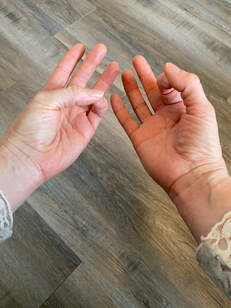 Bilateral stimulation is one of the ways we can help orient ourselves to the present moment and support our nervous system to regulate and ground to create a deeper sense of safety within the body. My favorite bilateral tool to use is called Tip Tap Fingers. This tool can be used to help create space in the mind from triggers and intrusive thoughts. This tool can also help us "keep our lids on" when we feel stressed or triggered. This bilateral brain game can be practiced in the following layers to continue to increase the mental challenge and help build more neuroplasticity in the brain. These tools can help us build resilience and learn to stay checked in with our body for a sense of safety. Tip Tap Fingers:
This past week, I was interviewed by Hannah Levin of Heartfelt Wellbeing where I talk about the practical applications of this tools along with other Yoga for Trauma principles and practices. To see the full interview on Yoga for Trauma, you can click here. For more trauma-informed tools, my Ethics of Trauma-Informed Care training starts on April 29th! You can choose between a live version or self-paced version with lifetime access to the recording. Click here for more information and to reserve a spot today!
0 Comments
Your comment will be posted after it is approved.
Leave a Reply. |
AuthorWrite something about yourself. No need to be fancy, just an overview. Archives
April 2024
Categories |


 RSS Feed
RSS Feed